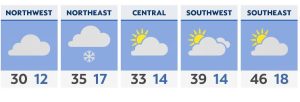The Department of Justice and the Bureau of Alcohol, Tobacco and Firearms on Friday announced a proposed rule to expand how the federal government regulates stabilizing braces, which can be used to convert pistols into shoulder-mounted, short-barreled rifles.
“The Justice Department has submitted a final rule that will serve as another important tool in our efforts to combat gun violence,” Attorney General Merrick Garland said in a call with reporters on Friday. “Short-barreled rifles present a deadly combination. They are easier to conceal than rifles and they are more powerful and lethal than pistols.”
The proposal would clarify the definition of the term “rifle” in the Gun Control Act and the National Firearms Act to include weapons with a rifled barrel with an attached stabilizing brace that would enable the weapon to be fired from the shoulder.
The Gun Control Act defines a pistol as “a weapon originally designed, made, and intended to fire a projectile (bullet) from one or more barrels when held in one hand,” while a rifle is defined as a firearm made “to be fired from the shoulder and designed or redesigned and made or remade to use the energy of an explosive to fire only a single projectile through a rifled bore for each single pull of the trigger.”
Short-barreled rifles are those with barrels less than 16 inches in length, as well as any firearm that “as modified, has an overall length of less than twenty- six inches,” per the DOJ.
It is this final definition officials are seeking to clarify, with Attorney General Merrick Garland asserting Friday that “short-barreled rifles must be subject to stricter legal requirements.”
“The final rule submitted today makes clear that firearm manufacturers and dealers and individuals cannot evade the important public safety protections passed by Congress simply by adding accessories to pistols that transform them into short-barreled rifles,” Garland added. “A stabilizing brace or other accessory transforms a pistol into a short-barreled rifle.”
The ATF will use a six-factor system to determine whether a modified firearm meets the clarified definition of a rifle, and would hence be subject to additional regulations.
Those six factors are length and length of the firearm; length of distance between the trigger mechanism and the rear of the firearm; whether there is a scope on the firearm requiring it to be fired from the shoulder and “whether or not the any extension on the back of the firearm […] is necessary for operation of the firearm,” officials said in part.
“The rule provides that the touch point for that analysis is whether or not there is sufficient surface area on the stabilizing brace or other accessory […] that can be shoulder fired,” administration officials said Friday.
Officials on Friday clarified in a call with reporters that the proposal is “not a new law,” rather an “interpretation […] providing the industry and general public with guidance as to how ATF is interpreting the term rifle and short-barrel rifle” in two federal gun statutes.
The regulations do not apply to stabilizing braces designed for individuals with disabilities, or braces that are not intended to convert a weapon to a shoulder-mounted firearm.
Individuals who already own firearms with stabilizing braces that meet the shoulder-mounted definition must either register their property with the government within 120 days of the rule being published in the federal register, or otherwise destroy or re-alter the gun so it does not have a shoulder-mounted option. Owners who fail to report such firearms will be subject to a $200 tax, which all new purchases will also be subject to.
Friday’s update is the culmination of a process the DOJ launched in 2021. During a White House Rose Garden ceremony marking what President Joe Biden called a “public health crisis” of gun violence, the president tasked Garland with proposing a rule to classify stabilizing braces for pistols as subject to the National Firearms Act, among other directives.
“Today’s action will save lives,” Biden wrote in a statement on Friday. “It builds on my Administration’s already historic record of executive action to reduce gun violence, and the enactment of the most significant bipartisan gun safety legislation in nearly three decades. But there is so much more to do.”




